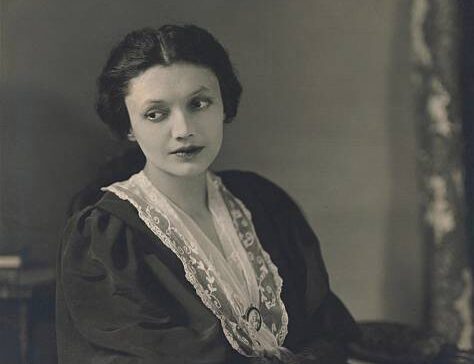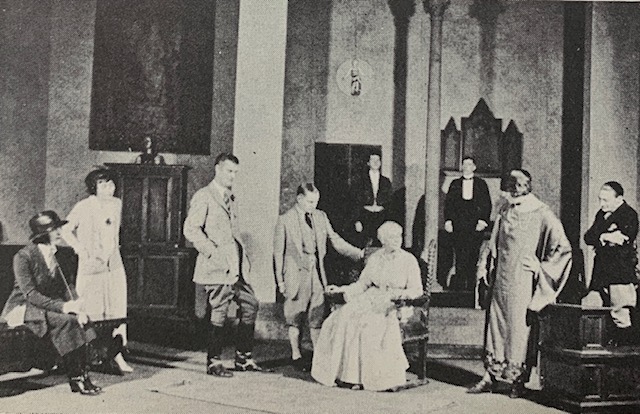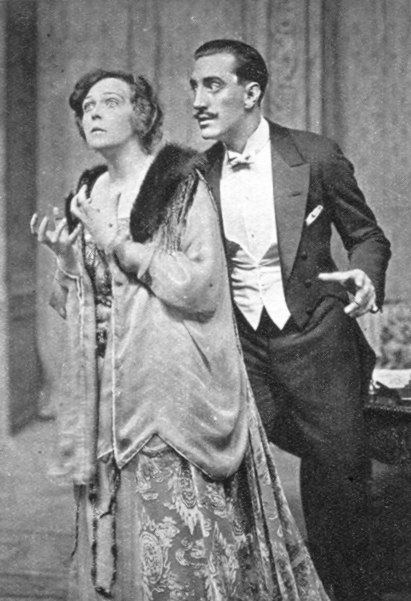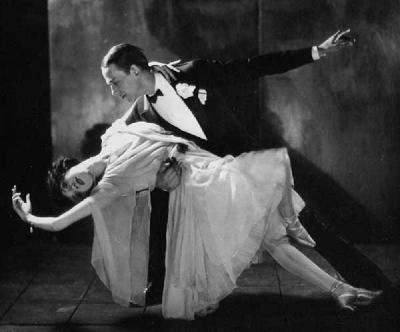
The Adding Machine, Dudley Digges
By Samuel L. Leiter
The New York theater season of 1922-1923 was memorable. According to my count (which differs a bit from other available surveys), 202 shows of every variety opened (down by a dozen or so from 1921-1922), Of those 202, 122 were new plays, the remainder being musicals, revues, and revivals. As in many seasons, some would be revived and studied for years; others—even hits or otherwise officially sanctified plays—are known only to buffs and historians.
How many of Burns Mantle’s top ten in his Best Plays of 1922-1923 do you recognize? Rain, You and I, Loyalties, Icebound, Why Not?, The Fool, Merton of the Movies, The Old Soak, R.U.R., and Mary the 3d. Chances are most readers are familiar with one, two, or three. On the other hand, many more are likely to know most of the following titles that did not make Mantle’s list: The Torch-Bearers, The Awful Truth, Six Characters in Search of an Author, The Tidings Brought to Mary, and The Adding Machine, all but one of which continue to be revived. Leiter Looks Back remembers their original Broadway stagings, in chronological order.
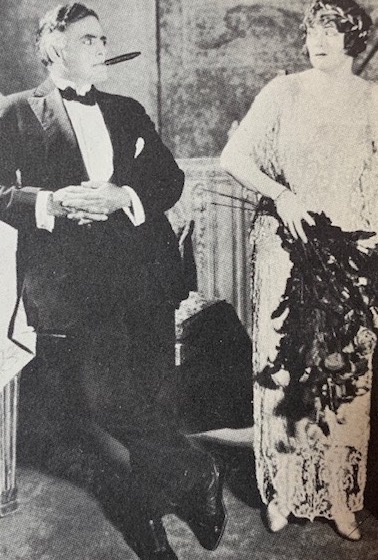

The Torch-Bearers: Arthur Shaw, Mary Boland
The funniest—even today, if well performed—was The Torch-Bearers (Forty-eighth Street Theatre, 8/22/22,123), which Kenneth Macgowan dubbed a “broad but keenly observed comedy.” It was the first full-length play by vaudeville actor and sketch writer George Kelly (uncle of Grace, who made her stage debut in a 1949 revival); Kelly also directed.
Its plot is thin, but its situations are so laughable no one usually cares. Considered by most a putdown of the mushrooming Little Theater movement, it struck Alexander Woollcott as “really a travesty on the amateur actor as he was at the beginning, is now, and ever shall be, world without end.” Which makes its frequent production by just such actors only more ironic.
Although it stumbled in its third act, the first two kept the bubble bouncing. The Torch-Bearers discloses the absorption of Mrs. Paula Ritter (Mary Boland) in the performance of a one-act planned under the imperious direction of a frustrated ex-actress, Mrs. J. Duro Paminelli (Allison Skipworth), who sees their suburban group’s production as a serious step in the Little Theater movement. Despite Mr. Ritter’s (Arthur Shaw) skepticism, the rehearsals proceed, providing hilarity at the expense of the silly and inept thespians. Even broader and funnier is the mishap-surrounded performance itself (think The Play That Goes Wrong), with one actor losing half his mustache, the scenery tumbling down, an actress tripping at her curtain call, and so on. Naturally, loads of flowers are bestowed on the cast, who assure themselves no one noticed their contretemps.
In the final act, Kelly suggested that he was not deriding the amateur craze, at least as long as it was “in the right hands,” but this weakened the comedy’s foundations. Ludwig Lewisohn asserted that the play “ended with a dull artifice.” Still, deftly played, especially by Boland and Skipworth, The Torch-Bearers contained enough honesty and penetrating satire to outlast most of its competitors.
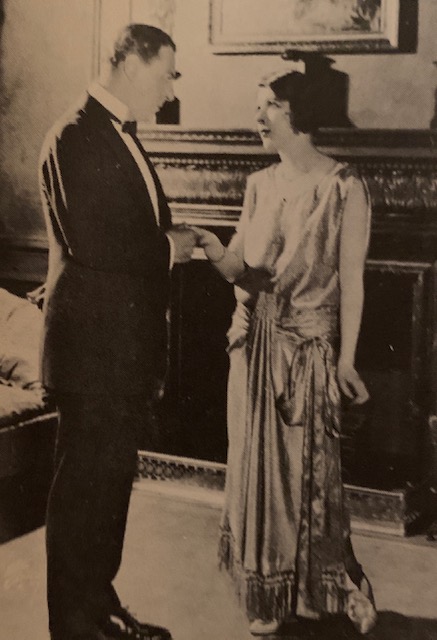

The Awful Truth – Bruce McRae, Ina Claire
The Awful Truth (Henry Miller’s Theatre, 9/18/22, 146), by Arthur Richman, is something of an outlier among the more artistically significant cohort described here. I include it because its 1937 Hollywood version (which followed two earlier films), directed by Leo McCarey, starring Cary Grant and Irene Dunne, is one of my favorite 1930s screwball comedies; the controversies surrounding its making, nicely described here, deserve a movie of their own.
On Broadway, it was little more than romantic comedy ephemera that, despite serious problems of plausibility, pleased most of the aisle-sitters. An attractive divorcée (Ina Claire), whose impending marriage to an Oklahoma oil man (Paul Harvey) is threatened by a story he hears about her past. Her first husband (Bruce McRae) bears witness to her character, but he and she fall in love again, and the oil man scurries happily home to the wide-open spaces.
Some said it was hard to accept the sophisticated divorcée’s innocence. An earlier version had actually established her as guilty, but this had been revised for popular consumption. Heywood Broun noted, “The play depends not upon its plot but upon brisk and amusing dialogue superbly handled.” Percy Hammond added that it was “A pretty play . . . , comprising interesting persons, amusing conversations, [and] smart, romantic situations.”
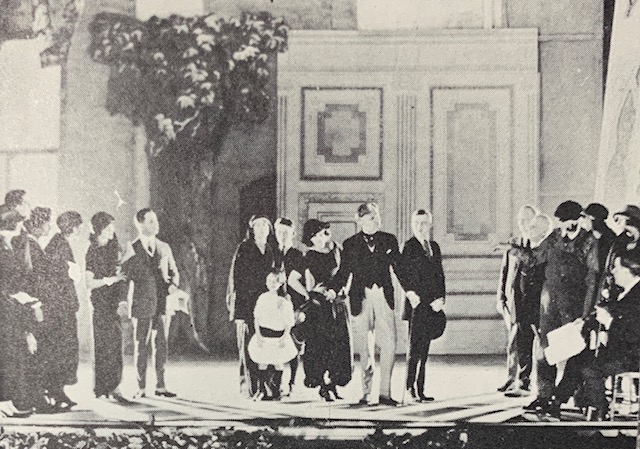

Six Character in Search of an Author
While there’s never been much interest in reviving The Awful Truth, that’s anything but the case with Italian playwright Luigi Pirandello’s Six Characters in Search of an Author (Princess Theatre, 10/30/22, 137). This theatrical warhorse, a satirical philosophic fantasy that has had a significant influence on modern playwriting, continues to be resuscitated throughout the world. Its New York premiere, in Edward Storer’s translation, was greeted as a refreshing, if controversial, novelty, with supporters and detractors. It was, however, deemed more a fascinating curiosity than a potential classic.
Kenneth Macgowan described it as “nothing short of a dramatization of an argument in aesthetics. It is a metaphysical discussion in stage terms. Identity, the reality of experience, the relation of life to art, make the substance of this play.” Stark Young thought it a work of “subtlety of analysis, originality of invention and brilliant and poignant stress of mentality,” magnificently constructed to weave the various strands of thought and action into a clear, cohesive, and suspenseful unity, creating “a kind of cerebral melodrama” that “gives the sense of cerebral solitude.” Walter Prichard Eaton commented on Pirandello’s satire on playwriting, in which he slapped the face of naturalism, but John Corbin argued that the satire was incomplete because it overlooked the chance of poking fun at the drama within the drama, the one about the six characters and their story.
Pirandello toys with the confusion between life and the illusion of life in theatrical production, by presenting the encounter of a stage director (Ernest Cossart) and his provincial stock company, during a rehearsal, with six characters, members of a family. Led by the Father (Moffat Johnston), they ask the actors to perform their story. The six, conceived by a playwright, but never realized in a play, cry out for dramatization. Their tale so intrigues the director that he has a stenographer copy down their drama as they express it, with the intention of giving it over to his actors.
But when the director and actors strive to stage the play in their own terms, the characters are disturbed by the disparity between their experience and its artistic distortion. Their story, which some found uncomfortably frank, is a domestic tragedy involving a passionate series of events, including adultery, incest, prostitution, and suicide.
Brock Pemberton’s well directed production gained plaudits for all, including Margaret Wycherly as the Mother and Florence Eldridge as the Daughter.
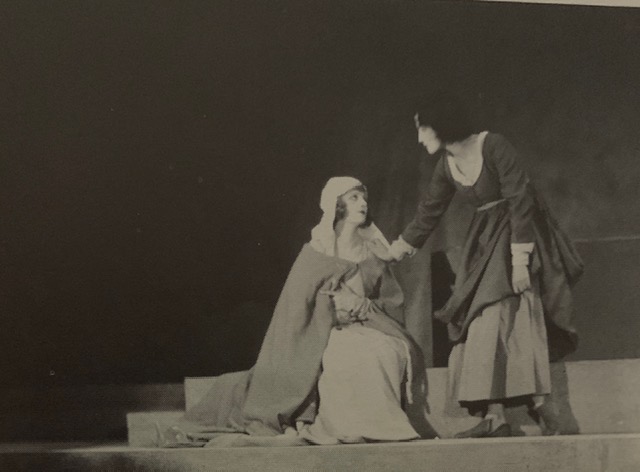

The Tidings Brought to Mary -Jeanne de Casalis, Mary Fowler
French playwright Paul Claudel, once world-famous as a leading exponent of poetic drama, is now rarely revived on the American stage. However, anyone who studied dramatic literature in the mid-20th century could not have avoided reading (and wrestling with) The Tidings Brought to Mary because of its presence in major anthologies of modern European drama. This 1910 play (revised by Claudel in 1948) was staged in L.M. Sills’s translation by the Theatre Guild (Garrick Theatre, 12/25/22, 32) under the direction of refugee Russian director Theodore Komisarjevsky.
The Tidings Brought to Mary is a mystical, poetic, often obscure drama written in the spirit of a medieval passion play. It attracted some critics by its sensitive beauties, but deterred others by its murkiness and the Guild’s inability to give it more than a merely competent performance. Most notable for many was the extreme simplicity, yet awesome power of Lee Simonson’s sets and lighting, as inspired by Komisarjevsky.
The pious and worthy Violaine (Jeanne de Casalis), on the eve of her wedding to Jacques (Percy Waram), kisses the leprous Pierre (Charles Francis) out of her abundant happiness. The kiss cures the leper but infects Violaine, in consequence of which Jacques believes her to have been unfaithful. He marries instead her mean-spirited sister Maria (Mary Fowler), who, some years later, has a child that dies. On Christmas Eve, as Mass is being said in the cathedral, she brings the baby’s corpse to her saintly outcast sister and begs her to pray for it. In a splendidly realized scene of offstage trumpets and special lighting, a miracle brings the child back to life. Violaine herself dies not long after, having explained all to the now penitent Jacques.
“It is a curiously undramatic composition,” remarked the Times, “of little appeal” to the mass of theatregoers. Yet Arthur Hornblow denounced the poor translation and the casting as major reasons for the failure. Stark Young submitted that the acting was “only so-so,” adding Claudel’s work was akin to “the drama of the mass.”
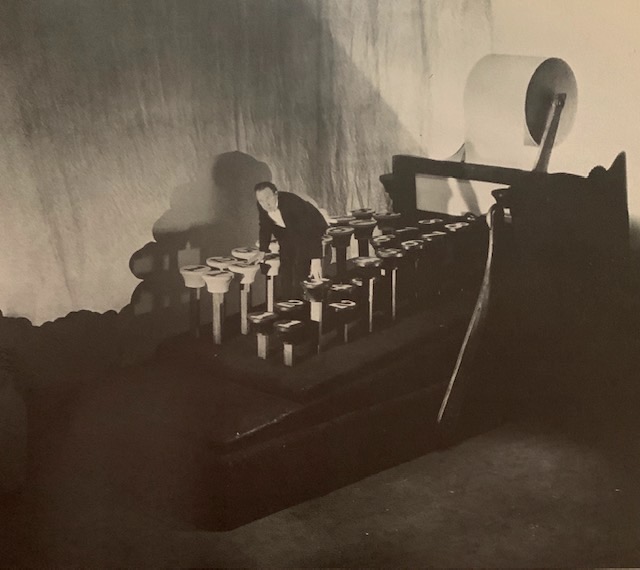

The Adding Machine – Dudley Digges
Last of the five, Elmer Rice’s The Adding Machine (Garrick Theatre, 3/19/23, 72), is another play that became an icon of its style, in its case the then rising, European-created method called expressionism. Again, the Theatre Guild, with Philip Moeller directing, was a leading force in the introduction of important avant-garde drama.
The play was conceived one night as Rice, sitting on his porch, thinking about another project, suddenly experienced the entire The Adding Machine flashing across his brain, even though it was on subject and in a style he had never thought about. He wrote in Minority Report that “I saw the whole thing complete: characters, plot, incidents, even the title and some of the dialogue. Nothing like it ever happened to me before or since.” Obsessed, he scribbled through the night, continuing for 17 days, in a manner he likened to “automatic writing.” The result was a seminal play of the 1920s.
Rice was hardly aware of expressionism at the time. His dramedy, which he labeled a “tragedy,” infuriated some not only because of its radical dramaturgy but because of its (for the times) coarse language, sexual innuendo, and themes blasting holes in the fabric of American judicial and labor practices. It also inspired hearty encomiums, and the controversy kept it running past its scheduled five-week run.
Given what most considered an exceptional staging, The Adding Machine began realistically but soon moved into a phantasmagorical telling of how the spineless, inarticulate, conservative clerk Mr. Zero (Dudley Digges), after a quarter century of slaving at a monotonous routine of counting figures for the Boss (Irving Dillon), finds out he is being replaced by an adding machine. Sent berserk by the news, he kills the Boss. Following a party at his and his wife’s (Helen Westley) apartment, he is arrested, tried, and convicted.
After being executed, Zero is seen in the cemetery, where his soul meets that of a matricide (Edward G. Robinson) and that of his former coworker, Daisy Diana Dorothea Devore (Margaret Wycherly), who committed suicide to follow him in death. Her offer of eternal love is spurned by the always respectable clerk. Finally, his blissful vision of operating a massive adding machine in heaven is interrupted so he may be sent back to earth for further progress toward regeneration.
Among the most noted scenes is one in which Zero and Daisy, on high stools, declaim in sing-song alternation an endless stream of figures, culminating in Zero’s being discharged. “The desks and the actors whirl about against a wall on which battalions of figures dance,” wrote Kenneth Macgowan: “suddenly in a great tumult everything is blotted out with two bloody splashes. Mr. Zero has ‘seen red’ and committed murder.” (A turntable and projections were responsible for the effects.) The courtroom scene, said the Times, showed “the Zero conception of justice, cold, inanimate, relentless, and the contrast between reality and unreality is heightened by the crooked bars and railings and walls.”
“Examine [Rice’s] play scene by scene, symbol by symbol,” advised Ludwig Lewisohn. “The structure stands. . . . [Here] is an American drama with no loose ends or ragged edges or silly last act compromises, retractions, reconciliations. The work, on its own ground, in its own mood, is honest, finished, sound.” Not everyone agreed, among them Macgowan, who pointed to the heaven scenes when the play “wanders off into a string of episodes that are anecdotal and satiric and without dramatic backbone.”
In the next installment of Leiter Looks Back, we’ll survey selected musicals from 1922-1923. Thirty were produced. Unlike the straight plays, though, none were classics. Which five will make the cut? Sally, Irene and Mary? Orange Blossoms? Up She Goes? Little Nelly Kelly? Liza? Wildflower? Look back with Leiter next week to find out.



